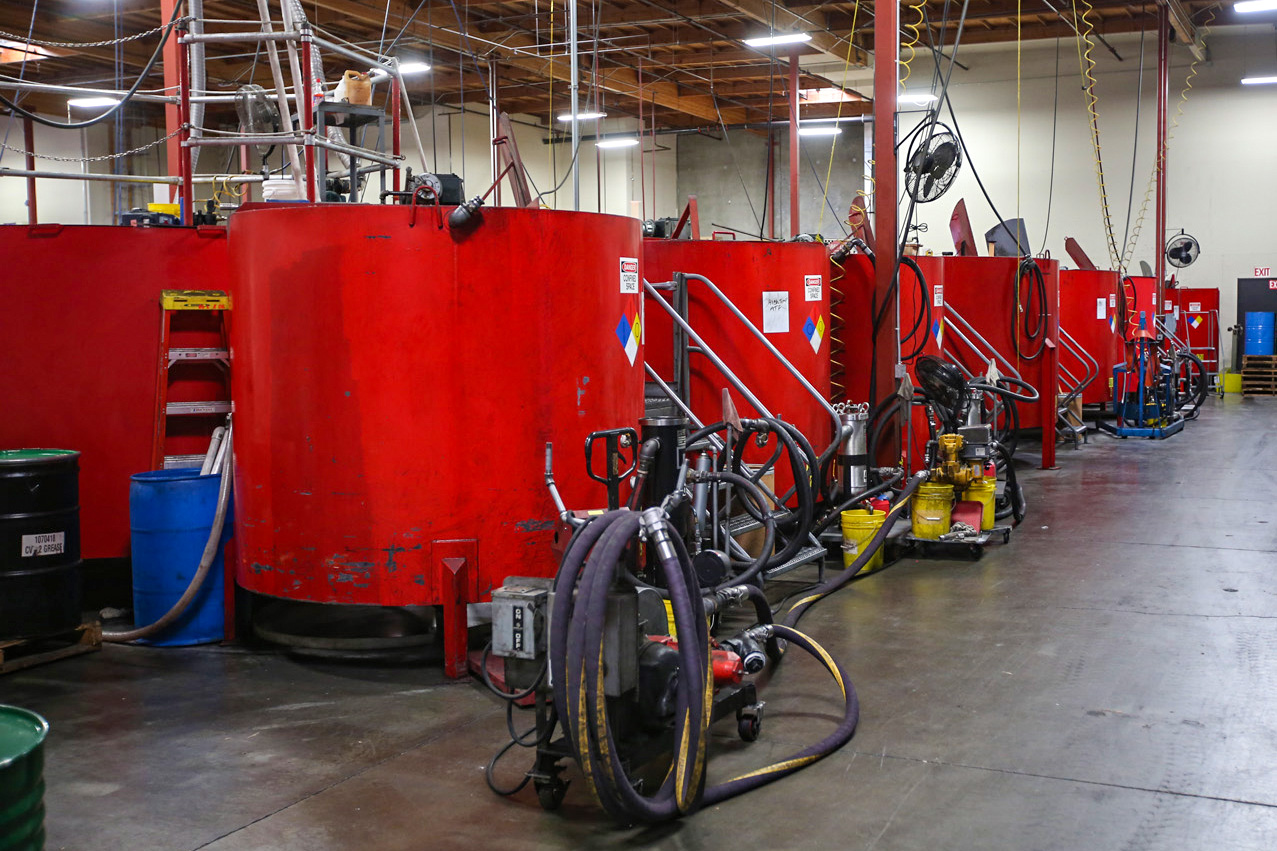Red Line Synthetic microbrews racing oil
Red Line Synthetic Oil was founded in 1979 and has been in the same manufacturing facility in Benicia, California, since 1996. The company was purchased by Phillips 66 in 2017, but not a lot changed. It still operates with a high level of autonomy and formulates its own products using Group IV and Group V base oils to create high-performance engine oil, transmission fluid, Water Wetter, and fuel additives.
Roy Howell, Red Line’s chief chemist and Vice President, started working at the company in 1986. He took us through the blending and packaging that all happens in the 32,000 square-foot facility.

Red Line has nine blending tanks, the largest of them is 5000 gallons. Eight of them make a finished product, a smaller, 1750-gallon tank blends an additive. Turning blades mix the additive into the base oil at room temperature.
Gasoline engine oils need a detergent/inhibitor additive package that makes up at least 6 percent of its total volume. That includes a detergent, a dispersant, an oxidation inhibitor, and zinc, for wear protection. A further two percent can be polymer added to stabilize viscosity. This is literally rubber. Diesel engine oil need 10-14 percent additive because it needs more dispersant to keep soot in suspension, plus a bit more detergent that helps with higher operating temperatures. Group IV and Group V bases will need less stabilizer than a conventional oil or Group III-based synthetic.

Red Line uses their own additive packs that contain 10-20 different raw materials, purchased from the same handful of manufacturers across the country also used by many larger oil companies. Some of the additives, like dispersants, are highly viscous at room temperature. Barrels of additives go into this oven and heat up for a few hours at 260 degrees until they’re thin enough to pour into the blending tanks and mix easily.
Red Line tries to minimize waste, so each barrel is left to drain further after another few hours in the oven. Total waste for the factory in a year wouldn’t even fill two of these drums.

We couldn’t take photos of the base oils (that’s stuff’s proprietary information) but Red Line uses a lot of Base IV to blend their oils, and it comes in 250-gallon totes rather than barrels. It’s made of polyalphaolefins (PAO) and it’s more resistant to heat than the Group III based used by most mainstream synthetic oil brands.
Once the base and additives are mixed, workers hook up pump and filter to the tank, which empties from the bottom and supplies the packaging line with product. That’s the coiled-up hose you can see in the foreground.

There are three packaging lines in the factory: additive, gallon, and quart. The additive line does 4-16-ounce bottles, the other two are pretty self-explanatory. About 90 percent of Red Line’s products are packaged by the quart and each line takes just three employees to run.

For the quart line, cylinders draw in a quantity of oil equal to the volume of the bottle and dispense it 10 at a time. The first batch down the line gets checked and weighed; if the quantity is off, the stroke length of the cylinders can be adjusted.
Some of Red Line’s fuel additives and lubricants get a drop of liquid nitrogen before being capped. The liquid turns into nitrogen gas to displace air in the packaging and keep the oil shelf-stable, so there’s no oxidation risk. All of the caps have an aluminized seal with a plastic coating. The tops of the bottles then move through a microwave that heats the plastic and melts the seals to the bottle. My microwave only works for frozen burritos and leftover Thai food.

The gallon filler doesn’t use a positive displacement filling system like the quart line. This one is gravity-filled, so the valve that’s opened to allow oil flow is regulated by time. The PVC pipe is in place when the line isn’t running to prevent any spills. It drains to a “drip drum” where it will be recycled and used to purge the lines.

When the product comes of the line it’s boxed and placed on a pallet, then moved to pallet racks. Red Line has one additional storage facility, but much of the product is developed, blended, packaged, and shipped to a distributor all under one roof.

